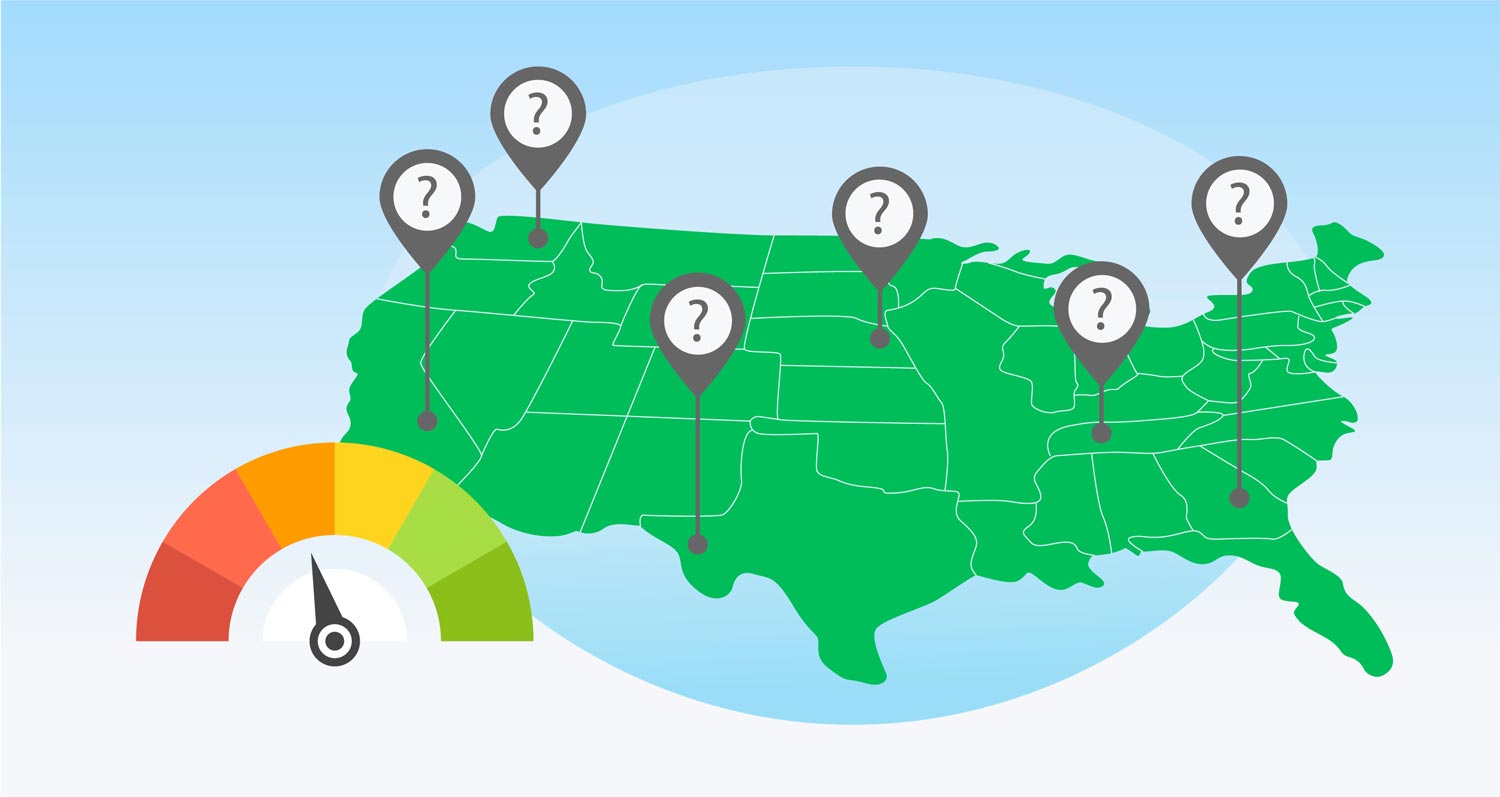A Life of Tax: How Much Tax Will Americans Pay Over Their Lifetime?

In 1789, Benjamin Franklin wrote that in life, “nothing can be said to be certain, except death and taxes”. Whether we like it or not, taxes are an essential part of any functioning economy. Tax dollars pay for everything from roads and infrastructure to schools and social security.
In 2023, the federal government collected over $2.18 trillion in personal income taxes. [1] U.S. Treasury Fiscal Data, ‘How much revenue has the U.S. government collected this year?’ https://fiscaldata.treasury.gov/americas-finance-guide/government-revenue/ But how much will the average American pay in income and other taxes throughout their lifetime?
This study has analyzed just how much tax the average person is estimated to pay in each state analyzing average incomes and expenditures across a number of categories.
Key statistics
- The average American will pay $524,625 in taxes throughout their lifetime — that’s a third (34.7%) of all estimated lifetime earnings ($1,494,986) spent on taxes.
- Residents of New Jersey will pay the most in lifetime taxes ($987,117) and people in West Virginia will pay the least ($358,407).
- Tax on earnings is where most tax will come from, with the average American paying $270,414 in a lifetime just on their wages.
- Owning the most popular car (Toyota Rav 4) will cost an additional $38,889 in tax payments alone, across the average four cars owned in a lifetime.
- Tax on property will set the average homeowner back an additional $165,492 on top of the purchase price and running costs.
- Taxpayers in Washington will pay the most on everyday expenses ($83,014), followed by those in California ($78,191), accounting for food, clothing, personal care, and entertainment.
Which states will pay the most in taxes over their lifetime?
Which states pay the most in taxes compared to their lifetime earnings?
It is important to understand that this analysis accounts specifically for tax on income and specific expenditure categories: cars, homes, clothing, food/drink, entertainment, and personal care. Other potential expenditures that may cause taxes to be paid throughout an individual’s life are not included in this study.
With this in mind, taxpayers in New Jersey are estimated to pay a total of $987,117 in taxes over their lifetime, which amounts to 54.3% of their lifetime earnings, the highest of any state.
Conversely, residents of West Virginia pay the lowest total taxes in the U.S., amounting to $358,407, or approximately 28.4% of their lifetime earnings. The Mountain State is one of 26 that slashed its personal and corporate income tax rates between 2021 and 2023, with some states doing so more than once in this period. [2] Center on Budget and Policy Priorities, ‘States’ Recent Tax-Cut Spree Creates Big Risks for Families and Communities’ https://www.cbpp.org/research/state-budget-and-tax/states-recent-tax-cut-spree-creates-big-risks-for-families-and
However, it is those living and working in Alaska who will pay the lowest percentage of their life’s earnings on tax. Residents in this state will pay $400,742 the equivalent of 24.5% of their lifetime earnings.
In the table below you can see a state-by-state breakdown of the average lifetime earnings compared to estimated lifetime taxes, and the percentage of earnings that will go toward tax payments.
| State | Lifetime earnings | Lifetime taxes | % of earnings |
|---|---|---|---|
| New Jersey | $1,818,191 | $987,117 | 54.3% |
| Connecticut | $1,731,261 | $855,307 | 49.4% |
| Vermont | $1,442,094 | $651,434 | 45.2% |
| New York | $1,658,872 | $748,199 | 45.1% |
| Massachusetts | $1,857,438 | $816,700 | 44.0% |
| New Hampshire | $1,674,402 | $722,610 | 43.2% |
| Rhode Island | $1,600,495 | $684,828 | 42.8% |
| Illinois | $1,580,130 | $665,286 | 42.1% |
| California | $1,589,377 | $659,224 | 41.5% |
| Maine | $1,420,847 | $581,750 | 40.9% |
| Mississippi | $1,212,292 | $481,017 | 39.7% |
| Nebraska | $1,441,423 | $546,354 | 37.9% |
| Wisconsin | $1,497,577 | $562,204 | 37.5% |
| Kansas | $1,405,670 | $525,482 | 37.4% |
| Texas | $1,437,047 | $531,438 | 37.0% |
| Washington | $1,729,531 | $631,249 | 36.5% |
| Iowa | $1,443,717 | $524,580 | 36.3% |
| Minnesota | $1,645,072 | $589,066 | 35.8% |
| Oregon | $1,461,612 | $521,500 | 35.7% |
| Utah | $1,397,411 | $493,368 | 35.3% |
| Pennsylvania | $1,508,483 | $532,077 | 35.3% |
| Virginia | $1,652,307 | $581,874 | 35.2% |
| Michigan | $1,386,964 | $487,842 | 35.2% |
| Maryland | $1,871,450 | $655,454 | 35.0% |
| Idaho | $1,254,081 | $420,886 | 33.6% |
| District of Columbia | $2,652,904 | $884,820 | 33.4% |
| Missouri | $1,392,011 | $463,997 | 33.3% |
| Hawaii | $1,581,119 | $521,966 | 33.0% |
| Colorado | $1,648,566 | $540,680 | 32.8% |
| Arizona | $1,443,082 | $470,554 | 32.6% |
| North Carolina | $1,381,529 | $450,446 | 32.6% |
| Ohio | $1,425,470 | $453,333 | 31.8% |
| Montana | $1,279,987 | $406,829 | 31.8% |
| Indiana | $1,405,776 | $443,271 | 31.5% |
| Kentucky | $1,307,340 | $411,333 | 31.5% |
| South Carolina | $1,326,469 | $416,183 | 31.4% |
| Nevada | $1,415,800 | $440,737 | 31.1% |
| New Mexico | $1,224,927 | $379,638 | 31.0% |
| Arkansas | $1,264,951 | $381,758 | 30.2% |
| Georgia | $1,422,823 | $426,896 | 30.0% |
| Tennessee | $1,359,081 | $390,663 | 28.7% |
| Oklahoma | $1,306,352 | $371,432 | 28.4% |
| West Virginia | $1,263,434 | $358,407 | 28.4% |
| Florida | $1,335,046 | $377,379 | 28.3% |
| Wyoming | $1,401,788 | $394,772 | 28.2% |
| Alabama | $1,296,399 | $360,053 | 27.8% |
| North Dakota | $1,523,518 | $422,314 | 27.7% |
| South Dakota | $1,390,105 | $380,130 | 27.3% |
| Louisiana | $1,318,458 | $358,611 | 27.2% |
| Delaware | $1,526,730 | $392,091 | 25.7% |
| Alaska | $1,632,895 | $400,742 | 24.5% |
These figures were calculated by adding both federal and state lifetime taxes across earnings, sales, property, and automotive, then compared against an estimated lifetime earnings figure based on the results of the latest American Community Survey [3] United States Census Bureau, ‘American Community Survey’ https://data.census.gov/table?t=Earnings%20(Individuals)&g=010XX00US$0400000 (with inflation applied to 2024) and multiplied by a working lifetime of 45 years from age 22 to 65 (the expected age of retirement). [4] American Enterprise Institute, ‘The Average US Retirement Age Increased over the Past 30 Years’ https://www.aei.org/research-products/report/the-average-us-retirement-age-increased-over-the-past-30-years/ The full breakdown of what went into this study can be read in the methodology below.
How much tax will the average American pay in their lifetime?
The average taxpayer in the U.S. will spend an estimated $524,625, around a third (34.7%) of all estimated lifetime earnings ($1,494,986) on various state and federal taxes. However, due to local property markets, salaries, and government actions, some states see taxpayers paying even more than the national average.
You can see the average American’s lifetime tax breakdown in the following chart:
Methodology
This study takes individual median earning information from the American Community Survey (2022) per state [3] United States Census Bureau, ‘American Community Survey’ https://data.census.gov/table?t=Earnings%20(Individuals)&g=010XX00US$0400000 and applies inflation to bring estimates up to 2024 based on salary growth estimates of 5% in 2023 and 5.1% in January 2024. [5] Federal Reserve Bank of Atlanta ‘Wage Growth Tracker’ https://atlantafed.org/chcs/wage-growth-tracker
The tax paid on earnings is for a single filer based on state-level taxes [6] Tax Foundation, ‘State Individual Income Tax Rates and Brackets for 2023’ https://taxfoundation.org/publications/state-individual-income-tax-rates-and-brackets/, federal income taxes [7] SmartAsset, ‘Federal Income Tax Calculator - Estimator for 2023-2024 Taxes’ https://smartasset.com/taxes/income-taxes, and FICA payments [8] Social Security Administration, ‘What is FICA?’ https://www.ssa.gov/people/materials/pdfs/EN-05-10297.pdf when applied to the average salaries in each state. The average salary is assumed to stay the same and tax rates remain stable over an individual’s working lifetime based on data available in February 2024. Retirement contributions were not factored in. Alaska, Florida, Nevada, South Dakota, Tennessee, Texas, Washington, and Wyoming do not implement a state income tax, while New Hampshire doesn’t tax income. New Hampshire does apply tax on dividends and interest but this type of asset was not analyzed in this study.
A working lifetime of 45 years was used to analyze income taxes. 62% of high school students attend college, [9] U.S. Bureau of Labor Statistics, ‘College Enrollment and Work Activity of Recent High School and College Graduates Summary’ https://www.bls.gov/news.release/hsgec.nr0.htm therefore this study assumes work life starts after a four-year degree based on age 22 until 65 years old (the current expected age of retirement). [4] American Enterprise Institute, ‘The Average US Retirement Age Increased over the Past 30 Years’ https://www.aei.org/research-products/report/the-average-us-retirement-age-increased-over-the-past-30-years/
Personal expenditure data comes from the Consumer Expenditure Report (2022) [10] U.S. Bureau of Labor Statistics, ‘Consumer Expenditure Survey’ https://data.bls.gov/PDQWeb/cx from the Bureau of Labor Statistics, specifically census regional spending on food, apparel, personal care, and entertainment per year. Expenditure is divided by 1.3, the average number of earners in a household. [11] U.S. Bureau of Labor Statistics, ‘Table 1203. Income before taxes: Shares of annual aggregate expenditures and sources of income, Consumer Expenditure Surveys, 2021’ https://www.bls.gov/cex/tables/calendar-year/aggregate-group-share/cu-income-before-taxes-2021.pdf to reflect an expenditure for one individual. The CPI Inflation Calculator was used to make expenditures applicable to January 2024. State-specific sales taxes were applied to expenditures and kept constant across categories of spending, ‘Combined Rates’ were used from the Tax Foundation which accounts for local sales taxes. [22] Tax Foundation, ‘State and Local Sales Tax Rates, Midyear 2023’ https://taxfoundation.org/data/all/state/2023-sales-tax-rates-midyear/
Property tax was calculated by using the cost of a single-family home in each state taken on the 31st December 2023, from Zillow. [12] Zillow, ‘Zillow Home Value Index (ZHVI): ZHVI Single-Family Homes Time Series ($)’ https://www.zillow.com/research/data/ An individual was assumed to own property from 35 (the age of the average first-time homebuyer) [13] National Association of Realtors®, ‘Highlights From the Profile of Home Buyers and Sellers’ (Accessed January 2024) https://www.nar.realtor/research-and-statistics/research-reports/highlights-from-the-profile-of-home-buyers-and-sellers to 79.7 (the average life expectancy). [14] United Nations, Life Expectancy https://population.un.org/dataportal/data/indicators/76/locations/840/start/1990/end/2023/table/pivotbylocation Some states have exemptions or rules of no property tax for those aged 65+, [15] Property Club, ‘States With No Property Taxes’ https://propertyclub.nyc/article/states-with-no-property-taxes this has been applied in the calculation in those states.
The study takes the age an individual can acquire a full license in each state up to the recommended driving age as dictated by the CDC. [16] Centers for Disease Control and Prevention, ‘Older Adult Drivers’ https://www.cdc.gov/transportationsafety/older_adult_drivers/index.html The study uses the average value ($28,675) of a Toyota RAV 4, the best-selling car of 2022. [17] Statista, ‘The best-selling cars and SUVs in the United States between January and December 2022’ https://www.statista.com/statistics/276419/best-selling-cars-in-the-united-states/ Drivers were assumed to stop driving at 70 years old, as the CDC highlights this is the age group with the highest car crash fatalities. [18] Center for Disease Prevention and Control, ‘Older Adult Drivers’ https://www.cdc.gov/transportationsafety/older_adult_drivers/index.html Based on the starting age in each state and 70 years as the final driving age, car owners were assumed to own an average of four cars over a lifetime based on the fact that consumers typically keep a car for around 12.5 years. [19] Reuters, ‘US consumers keep vehicles for a record 12.5 years on average -S&P’ https://www.reuters.com/business/autos-transportation/us-consumers-keep-vehicles-record-125-years-average-sp-2023-05-15/ In each state car ownership may be 4.1 or 4.2 cars but four whole vehicles were analyzed instead.
Car property tax was taken from a WalletHub study [20] WalletHub, ‘2023’s Property Taxes by State’ https://wallethub.com/edu/states-with-the-highest-and-lowest-property-taxes/11585#vehicle analyzing this average cost in each state based on respective Department of Motor Vehicles data using weighted averages based on population size in cities and counties that account for at least 50% of a state’s population.
Inheritance tax was excluded from this study as it was deemed the average American would not have to pay this due to inheritance thresholds not being exceeded. Only 6 states have an inheritance tax and according to 2021 data from the IRS just 0.2% of U.S. adults who die have owed estate tax in recent years. [21] Internal Revenue Service, ‘Taxable Estate Tax Returns as a Percentage of Adult Deaths, Selected Years of Death’ https://www.irs.gov/statistics/soi-tax-stats-historical-table-17
Marriage and its effect on taxes were not applied to this study as it did not impact taxes in the vast majority of cases representing the average American taxpayer.
This study was initially run in February 2021, and then updated in March 2022, March 2023, and February 2024.
Sources
- [1] U.S. Treasury Fiscal Data, ‘How much revenue has the U.S. government collected this year?’ https://fiscaldata.treasury.gov/americas-finance-guide/government-revenue/
- [2] Center on Budget and Policy Priorities, ‘States’ Recent Tax-Cut Spree Creates Big Risks for Families and Communities’ https://www.cbpp.org/research/state-budget-and-tax/states-recent-tax-cut-spree-creates-big-risks-for-families-and
- [3] United States Census Bureau, ‘American Community Survey’ https://data.census.gov/table?t=Earnings%20(Individuals)&g=010XX00US$0400000
- [4] American Enterprise Institute, ‘The Average US Retirement Age Increased over the Past 30 Years’ https://www.aei.org/research-products/report/the-average-us-retirement-age-increased-over-the-past-30-years/
- [5] Federal Reserve Bank of Atlanta ‘Wage Growth Tracker’ https://atlantafed.org/chcs/wage-growth-tracker
- [6] Tax Foundation, ‘State Individual Income Tax Rates and Brackets for 2023’ https://taxfoundation.org/publications/state-individual-income-tax-rates-and-brackets/
- [7] SmartAsset, ‘Federal Income Tax Calculator - Estimator for 2023-2024 Taxes’ https://smartasset.com/taxes/income-taxes
- [8] Social Security Administration, ‘What is FICA?’ https://www.ssa.gov/people/materials/pdfs/EN-05-10297.pdf
- [9] U.S. Bureau of Labor Statistics, ‘College Enrollment and Work Activity of Recent High School and College Graduates Summary’ https://www.bls.gov/news.release/hsgec.nr0.htm
- [10] U.S. Bureau of Labor Statistics, ‘Consumer Expenditure Survey’ https://data.bls.gov/PDQWeb/cx
- [11] U.S. Bureau of Labor Statistics, ‘Table 1203. Income before taxes: Shares of annual aggregate expenditures and sources of income, Consumer Expenditure Surveys, 2021’ https://www.bls.gov/cex/tables/calendar-year/aggregate-group-share/cu-income-before-taxes-2021.pdf
- [12] Zillow, ‘Zillow Home Value Index (ZHVI): ZHVI Single-Family Homes Time Series ($)’ https://www.zillow.com/research/data/
- [13] National Association of Realtors®, ‘Highlights From the Profile of Home Buyers and Sellers’ (Accessed January 2024) https://www.nar.realtor/research-and-statistics/research-reports/highlights-from-the-profile-of-home-buyers-and-sellers
- [14] United Nations, Life Expectancy https://population.un.org/dataportal/data/indicators/76/locations/840/start/1990/end/2023/table/pivotbylocation
- [15] Property Club, ‘States With No Property Taxes’ https://propertyclub.nyc/article/states-with-no-property-taxes
- [16] Centers for Disease Control and Prevention, ‘Older Adult Drivers’ https://www.cdc.gov/transportationsafety/older_adult_drivers/index.html
- [17] Statista, ‘The best-selling cars and SUVs in the United States between January and December 2022’ https://www.statista.com/statistics/276419/best-selling-cars-in-the-united-states/
- [18] Center for Disease Prevention and Control, ‘Older Adult Drivers’ https://www.cdc.gov/transportationsafety/older_adult_drivers/index.html
- [19] Reuters, ‘US consumers keep vehicles for a record 12.5 years on average -S&P’ https://www.reuters.com/business/autos-transportation/us-consumers-keep-vehicles-record-125-years-average-sp-2023-05-15/
- [20] WalletHub, ‘2023’s Property Taxes by State’ https://wallethub.com/edu/states-with-the-highest-and-lowest-property-taxes/11585#vehicle
- [21] Internal Revenue Service, ‘Taxable Estate Tax Returns as a Percentage of Adult Deaths, Selected Years of Death’ https://www.irs.gov/statistics/soi-tax-stats-historical-table-17
- [22] Tax Foundation, ‘State and Local Sales Tax Rates, Midyear 2023’ https://taxfoundation.org/data/all/state/2023-sales-tax-rates-midyear/





